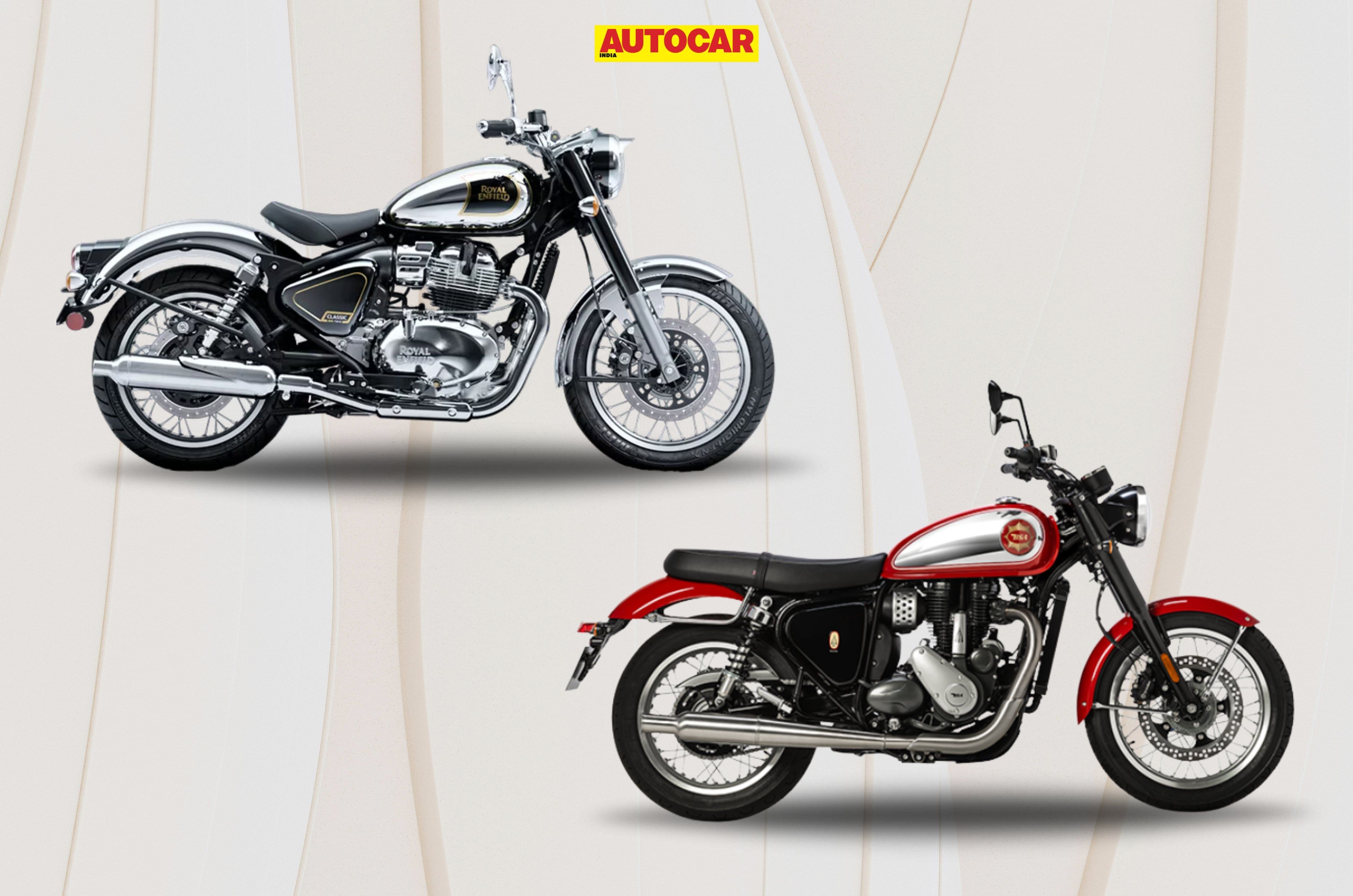
A few months back, Royal Enfield launched the long-awaited Classic 650, and outside of its twin-cylinder brethren, its closest rival is the BSA Gold Star 650. Here’s how Royal Enfield’s biggest Classic shapes up against the 21st-century ‘Goldie’ on paper.
Royal Enfield Classic 650 vs BSA Gold Star 650: Engine and output
Very different engines that are very similar in terms of output
| Engine and output | ||
|---|---|---|
| Royal Enfield Classic 650 | BSA Gold Star 650 | |
| Engine | 648cc, twin-cyl, air/oil-cooled | 652cc, single-cyl, liquid-cooled |
| Power | 47hp at 7,250rpm | 45hp at 6,500rpm |
| Power-to-weight ratio | 193.4hp per tonne | 211.3hp per tonne |
| Torque | 52.3Nm at 5,650 rpm | 55Nm at 4,000rpm |
| Gearbox | 6-speed | 5-speed |
The engine is one area where these bikes couldn’t be further apart. The Classic 650 is powered by Royal Enfield’s tried-and-tested twin-cylinder motor, and here it makes the same output as almost all its other stablemates. In contrast, the Gold Star is powered by a Rotax-sourced big single-cylinder engine that has been brought up to date to meet the latest emission standards.
Despite these differences in the number of cylinders and engine architecture, the outputs of both bikes are quite evenly matched. However, as you’d expect, the riding experience is quite different; the Classic’s mill is strongest in the midrange and revs higher, while the BSA’s thumper pulls strongly right from the bottom but peaks earlier. Exhaust sound is another area where these bikes are very different, and the Royal Enfield has a typical, smooth, burbly 270-degree twin-cylinder soundtrack, where the BSA has a booming, relatively thrashy big single-cylinder exhaust note. Both engines are quite smooth, too, although the Classic has a small edge here owing to its extra cylinder and sixth gear, albeit it must be said that the Gold Star’s five gear ratios are quite well-spaced.
Royal Enfield Classic 650 vs BSA Gold Star 650: Weight and dimensions
Gold Star is 30kg lighter, much lower and slimmer than the Classic
| Weight and dimensions | ||
|---|---|---|
| Royal Enfield Classic 650 | BSA Gold Star 650 | |
| Kerb Weight | 243kg | 213kg |
| Seat Height | 800mm | 780mm |
| Ground Clearance | 150mm | 150mm |
| Fuel Tank Capacity | 14.8 litres | 12 litres |
| Wheelbase | 1475mm | 1425mm |
With a full 30 kilos separating the Classic from the Gold Star, it’s unsurprising that the latter has the higher power-to-weight ratio and is sure to feel more welcoming to a wider audience of riders. Add to that, it also has a lower perch, and the Classic’s wider twin-cylinder engine splays the rider’s legs out quite a bit, a factor not existent on the BSA with its slimmer single-cylinder engine.
The Gold Star’s wheelbase is also a massive 50mm shorter (a small number that will make a big difference to how the bike behaves on the road), which will help it feel more agile and manoeuvrable in every situation. Conversely, the Classic will feel more planted at highway cruising speeds, also in part due to its heavier kerb weight.
Speaking of going on the highway, the Classic will be able to go a little further than the Goldie because it carries nearly 3 full litres more. Both have adequate amounts of ground clearance available and should be more than usable on most terrain you’ll encounter on a long journey.
Royal Enfield Classic 650 vs BSA Gold Star 650: Suspension, tyres and brakes
Classic has bigger wheels and a larger rear brake disc
| Suspension, tyres and brakes | ||
|---|---|---|
| Royal Enfield Classic 650 | BSA Gold Star 650 | |
| Suspension (F/R) | Telescopic fork / Twin shock absorbers | Telescopic fork / Twin shock absorbers |
| Brakes (F/R) | 320mm disc / 300mm disc | 320mm disc / 255mm disc |
| Tyres (F/R) | 100/90-19 / 140/70-R18 | 100/90-18 / 150/70-R17 |
Both bikes have similar suspension setups, and our complaint with both is also rather similar. Where the Classic’s shocks are a little too firm, the Gold Star’s are a little underdamped – both resulting in less than ideal suspension comfort on our far from perfect roads. The Classic has a huge 300mm rear disc, but that’s in keeping with its portly kerb weight. The Royal Enfield also has the more period-correct wheel sizes in comparison to the modern roadster-y wheel sizes on the BSA.
Royal Enfield Classic 650 vs BSA Gold Star 650: Features
RE the more loaded machine here, BSA more authentically retro
Since these are relaxed retro roadsters, features aren’t a big consideration for most people in this class. Even so, the Classic 650 is clearly ahead of the Gold Star here. It has the Tripper navigation pod as standard, adjustable levers, a centre stand (a handy feature when you need to fix a puncture on a tube-type tyre), a discreetly tucked away USB-C charger, and it also shows you the gear position on the small digital readout on its display.
In comparison, the BSA’s clocks are relatively spartan, missing out on a gear position indicator, and the small digital insets showing you other information like fuel level, trip reading, odometer, etc, are also quite small and not easily readable if ambient lighting is harsh or dim. A couple of neat touches, however, are that the BSA’s needles are mounted just like the ones on the original Gold Star, and the amber backlight is a neat touch, too.
Royal Enfield Classic 650 vs BSA Gold Star 650: Price
BSA’s starting price much more accessible, top models priced quite close
| Price | ||
|---|---|---|
| Royal Enfield Classic 650 | BSA Gold Star 650 | |
| Price | Rs 3.37 lakh – Rs 3.50 lakh (ex-showroom, Chennai) | Rs 3.10 lakh – Rs 3.45 lakh (ex-showroom, Delhi) |
The Gold Star’s starting price is much more affordable than the Classic’s, although near the top, there’s only a Rs 5,000 difference. And since the only difference between the base and top models on both bikes is only colours, not any equipment or part differences, the lower versions of the BSA are good VFM here.
Also See: BSA Gold Star 650 vs Royal Enfield Interceptor 650 comparison review






